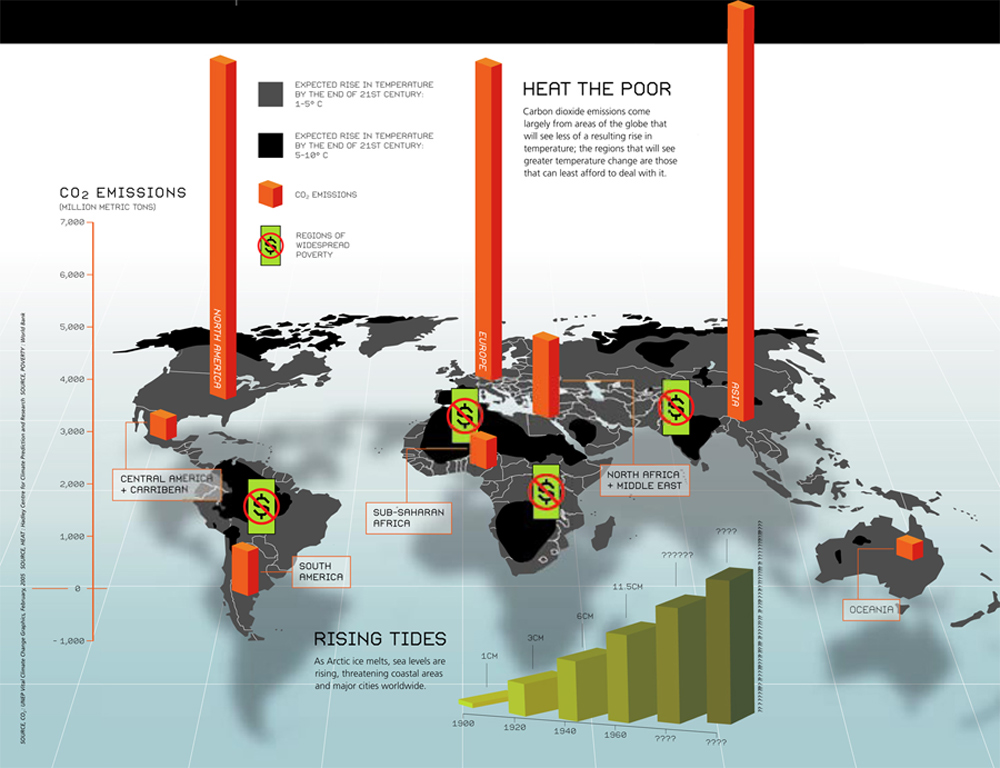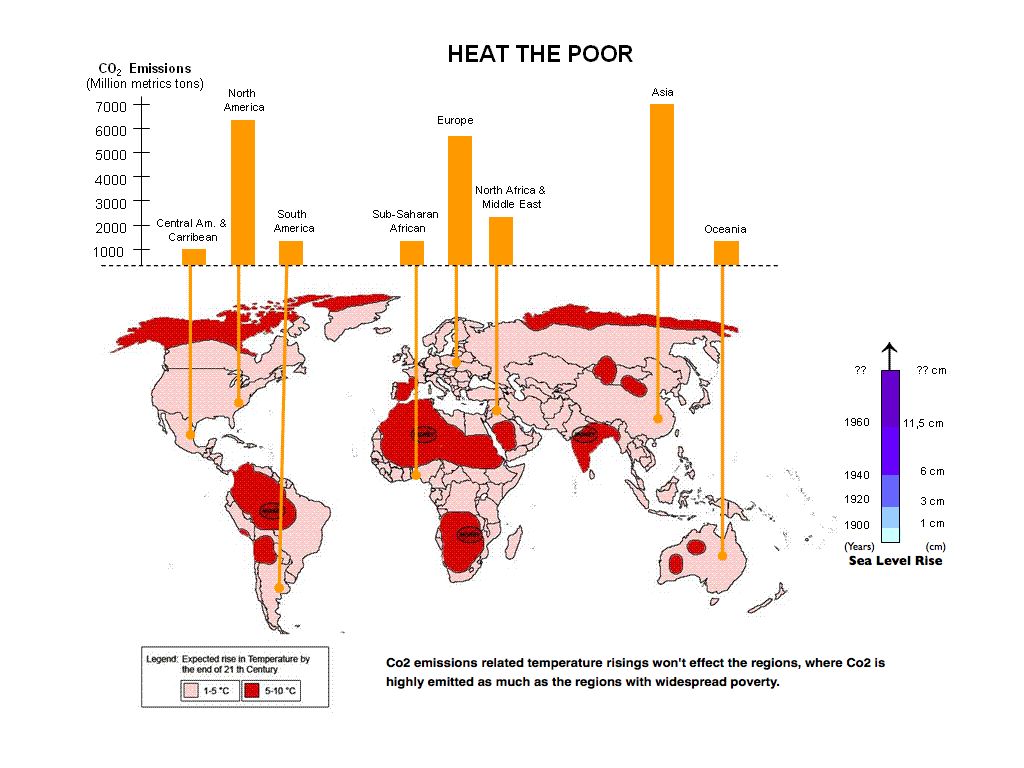Teaching:TUW - UE InfoVis WS 2008/09 - Gruppe 01 - Aufgabe 3
Jump to navigation
Jump to search
Aufgabenstellung
Zu beurteilende Grafik
The corrections and critics on the graphic are based on the design principles of Few [2004].
Critics on the Graph
- Non-data ink is high and there is unnecessary data ink :
- Shadowing and the 3-D visualization of the World Map, 3d visualization of the CO2 emissions and rising tides (sea level rise), these objects increase the non-data ink, thus decreasing the data-ink ratio.
- 3-D CO2 Emission Bars block some of the regions which are supposed to convey important information. Thus decreasing or blocking the data-ink. (Especially the regions in black are blocked by these bars.)
- The icon, which aims to emphasize regions of poverty, blocks important information and de-emphasizes the data-ink, although this icon doesn't convey a precise information.
- The Bar diagram of Sea Level Rise is reducing the priority of other important data ink, and this information is seems to be an unnecessary data ink.
- Consequently the real message or data is not supported in the Graph, which is against the task of visualizing quantitative information.
- The data is unorganized :
- The essential message of the graph is not clear, CO2 emissions of Regions ? Heat the Poor ? or the rising sea levels ?
- It is not clear which data has more priority.
- The data is not sequenced, thus confusing the readers. In other words there is no direction for order in which data should be read.
- Scales,Plots and Texts :
- The CO2 Emissions scale on the left side of the graph can't be taken as a reference, cause it is far away from the CO2 emission bars.
- The negative axis of CO2 Emissions scale refers to nothing, since CO2 emissions can't have a negative value.
- The Bar diagram which aims to show the relationship between time and sea level rise has an unclarity and this diagram stands in the graph as if it is as important as the other data ink. It is not written on the axes what they refer to. Does the y-axis represent rising sea levels ? and Does the x-axis refer to time in years ?, instead there is a text which is an unnecessary data ink.
- It is not easy to guess what the graph is about, because of the missing clear titles and introduction. How should be the graph interpreted by readers ?
- The sequence could have been clarified with some text, but in the following graph there is no sequence, therefore the current placements of the texts are not helping the readers to find an order in which data should be read.
Corrections on the Graph
Changes on the Graph
- Reduction of non-data ink and Enhancement of data ink :
- Shadowing and 3-D visualizations are removed, thus the non-data ink is reduced.
- 3-D CO2 Emission Bars are removed, transformed into 2-D bars and placed at the uppermost segment of the graph, so that no data ink is blocked by any other data ink. Thus data ink is enhanced.
- The icon for the regions of poverty is removed, replaced with a smaller one that it doesn't block other data ink anymore. Thus enhancing the data-ink.
- Consequently the real message and additional information of the graph are clearly supported in the graph.
- Data organizing :
- The data is reorganized by separating the graph into 3 parts.
- CO2 Emission plot with bars (uppermost part)
- Expected rise in temperature with respect to regions on the world map
- Sea Level Rise bar diagram
- The essential message of the graph and additional information are clarified.
- Message of the graph : Co2 emissions related temperature risings won't effect the regions, where Co2 is highly emitted as much as the regions with widespread poverty.
- Additional information : Expected rise in temperature with respect to regions in order to show the essential message of the graph and rising sea levels threatening the coastal areas as an extra info.
- The data is sequenced by separating the graph into 3 parts.
- The data is reorganized by separating the graph into 3 parts.
- Scales,Plots and Texts :
- The CO2 Emissions scale on the left side of the graph is removed and a new one with only positive values is placed next to CO2 bars.
- The Bar diagram of rising sea levels is transformed and simplified. The Text of this plot is replaced with a simple title. Thus enhancing the more important data ink and taking less attention.
- The unnecessary text under the title Heat The Poor is replaced with a shorter one, thus introducing the graph to readers.
References
- [Few, 2004]:Stephen Few, Show Me the Numbers: Designing Tables and Graphs to Enlighten, Analytics Press, 2004, Chapter 7 - General Design for Communication.

